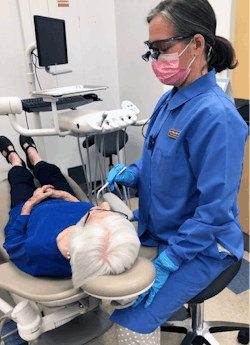Saddle seating: Choosing the right design for the right reasons
A decade ago, very few clinicians used saddle stools, and there were very few designs to choose from back then. But since 2010, an increasing number of clinicians now use some type of saddle, and many dental hygienists are choosing to purchase their own.
Saddle seating benefits
Dangerous assumptions
Online forums are peppered with questions and comments about saddle seating. Some of the information is good, while other comments that are not scientifically based can convince a clinician to select a saddle that simply does not fit. A clinician who uses the wrong saddle design or one that is improperly adjusted may assume that saddle seating is bad, rather than realizing the product was the wrong style for their body shape and size.
Additional reading:
- Hygienists are becoming serious purchasers
- Ergonomic synergy: Creating a functional, low-stress workspace
The decision on what saddle to choose often gets clouded by two different issues. First, we are all shaped differently. It is dangerous to assume the saddle design that works well for a colleague would also be your best option. This plan only works if you are the same exact size and shape. The second issue that creates problems is assuming an inexpensive, basic saddle can offer the same experience as a well-constructed saddle specifically designed for the spatial demands of a dental treatment room. There are several unintended consequences: the product does not hold up well over time, does not fit the user, or can’t be properly adjusted. There’s that old adage “you get what you pay for.”
Seat pan design and size
Selecting the right saddle is critical. Five different physical factors need to be considered when selecting a saddle: pelvic width, size of torso, hip flexibility, overall height, and leg length. Each factor plays a critical role in determining the optimal design for the user.
Seat pan shapes and designs vary. There are six basic designs in the market today, and like most products, there can be slight variations between different brands. The first thing to consider is the user’s pelvic width. A clinician who is very narrow through the hips will feel more comfortable with a slender seat pan that keeps their legs closer together. There are several narrow saddles that accommodate this type of physical profile, and a Western saddle is typically the narrowest design available.
Other seat pan designs support an average pelvic width. There are also versions that accommodate clinicians with larger or wider frames. The most important consideration is to find a seat pan that supports the user’s buttocks and thighs and feels comfortable in the hips. The bottom line is based on the Goldilocks concept. A narrow saddle will not work properly for a person with a larger frame, and conversely a clinician who barely fits into adult-sized pants will be terribly uncomfortable with a medium or large seat pan.
Along with a person’s frame size, weight comes into play. Chairs of all designs have maximum weight limits. There are saddles specifically built to accommodate clinicians with larger torsos. Split seats are a further refinement in the saddle world. While this design feature might be considered gender specific, it is important to test sit specific designs before making a final selection.
Hip flexor muscles also play a role in finding the right design. Clinicians with very tight muscles find it is uncomfortable to sit in a wide tripod stance. This is a common issue for those with a narrow pelvis. Narrow saddles, or those that keep the legs closer together, are a better option for a clinician with limited hip flexibility.
The front profile of the saddle should be minimal. Saddles with a prominent horn or large projection at the front are not optimal for the dental setting and can create discomfort.
Cylinders: The other critical component
While most think that overall height is important when selecting the right saddle stool, it is not the correct determinant. People’s bodies vary in proportion. There are three different body types. Imagine three different people who are all the same height. A person who is short from shoulders to waist and has long legs is considered short-waisted. The next person might have a very long torso and very short legs, while the third may be considered evenly proportioned. Actual leg length, or what is called the inseam measurement, is the critical factor in determining the correct cylinder to order.
Both leg length and torso measurements impact how our clothes fit, and these two factors impact what hydraulic cylinder will work best for the user. My husband and I illustrate this concept clearly. He is a foot taller than me, but my inseam length is only one-and-a-half inches shorter than his, so we are very different proportionally. Despite our difference in height, we both use a tall cylinder.
Everyone is different. Know your inseam length and select a cylinder that will allow you to increase the saddle height over time. Clinicians who are new to the saddle world will gradually adjust the height of the seat pan over a period of months, so select a cylinder that can accommodate a range of height adjustments.
The art and science of the right design
A saddle simply needs to be right for the user, and it needs to be properly adjusted. Many assume that the seat pan tilt must be steep, but most people find a 5- to 15-degree forward tilt is optimal. When properly adjusted, the front rim of the saddle should be visible, feet flat on the floor, with the buttocks and thighs evenly positioned on the seat pan, and the hips higher than the knees, ideally at a 115-degree angle. This positioning creates the ideal seating experience.
Choosing the right saddle that corresponds to your own measurements is critical. What happens when a saddle fits the user and is adjusted correctly? The clinician is comfortable, works more safely, and can concentrate on their clinical assignment. There are no downsides to getting the right saddle.
Editor's note:This article appeared in the May 2022 print edition of RDH magazine. Dental hygienists in North America are eligible for a complimentary print subscription. Sign up here.About the Author
Anne Nugent Guignon, MPH, RDH, CSP
ANNE NUGENT GUIGNON, MPH, RDH, CSP, has received numerous accolades over four decades for mentoring, research, and guiding her profession. As an international speaker and prolific author, Guignon focuses is on the oral microbiome, erosion, hypersensitivity, salivary dysfunction, ergonomics, and employee law issues. She may be contacted at [email protected].


